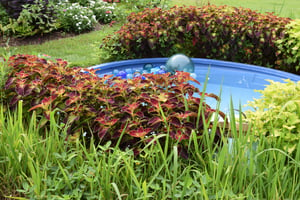
How to Keep Deer Out of Your Garden
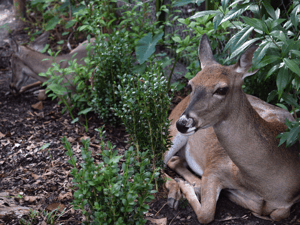
Brie the Plant Lady here with some advice on how to protect your precious plants from grazing deer and other critters. This is an excerpt from her book, Gardening With Grains.
Is it Deer-Proof?
It’s the question on so many gardeners’ minds. If you have ever listened to a presentation of mine, you know I have some creative ideas for dealing with browsing mammals. But to answer that question, Is it deer-proof? NO! No plant is entirely “deer-proof.” I promise, the moment you start to feel confident that you have outsmarted them, they will prove you wrong. And somehow these animals seem to know how much you spent on a plant – the bigger the investment, the more likely they will eat it to the point of no return.
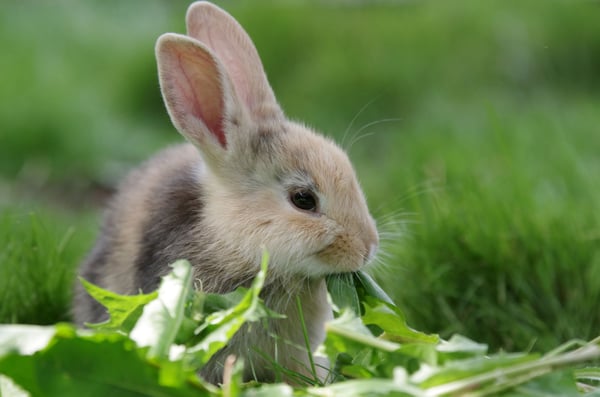
Arugula's bitter leaves deter munching rabbits and deer.
As I travel the country, I have come to realize that I have it easy here in central North Carolina. Sure, we have deer, rabbits, groundhogs, and squirrels, but that’s nothing compared to wild hogs, bears, or antelopes. A friend once declared to me that I would French kiss a deer the day the armadillos make it to my garden! (Did you know armadillos are making their way north and east?) These meat eaters don’t graze in your garden, they voraciously dig holes everywhere in search of grubs and other ground-living insects, uprooting your plants and ruining your lawn. So, appreciate the creatures you have because it could always be worse.
Whose Neighborhood Is It?
To really dive into this topic, which all gardeners seem to share an interest in, we must first think about why we have the wildlife pressure in our residential developments. During an inspiring and insightful lecture by Nancy Lawson (master naturalist, author, and founder of Humane Gardener, an initiative dedicated to animal-friendly landscaping methods), my eyes were opened to the importance of being a better steward – not just to the land I cultivate but to the wildlife that my neighborhood displaced.
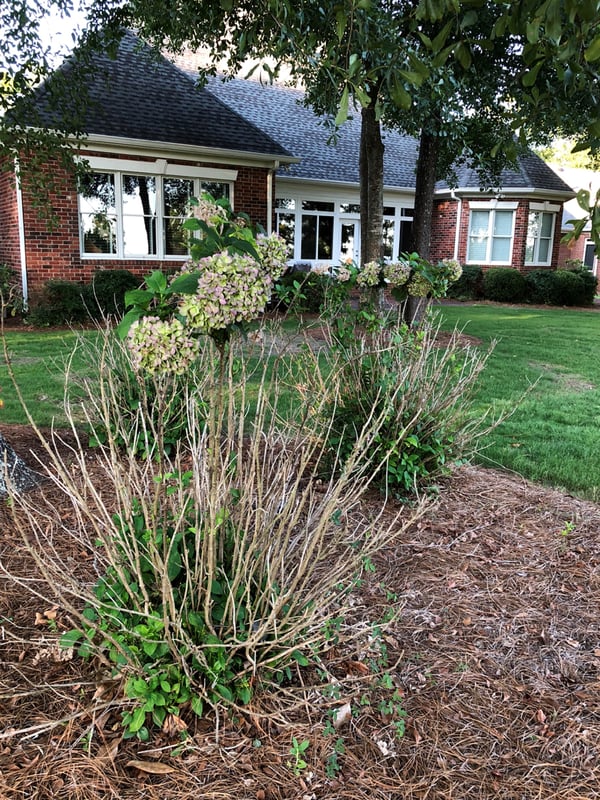
Hydrangea are favorites of both gardeners and deer. Have you ever heard that deer love all plants that start with H? It’s true! Hosta, Hydrangea, Heuchera, Hemerocallis (daylily): all deer candy.
It’s a conundrum: On one hand it is annoying to have my garden eaten by a herd of passing deer. But think about it – we tore down their home (nature) to build ours. Then we eliminated the native plants they had lived on and replaced them with exotic specimens that are irrigated and fertilized, growing plump and lush. Of course, they are going to eat from our landscapes – it’s a smorgasbord!
My Not-To-Do List
Over the past twenty years of gardening I have tried just about everything. Many of the most effective strategies are cost prohibitive, like installing a 10’ tall deer fence around your property, with chicken wire buried 2’ deep to keep out armadillos, rabbits, and groundhogs. Not only is that expensive, but for most people living in suburban developments, it isn’t allowed.
Here are some things you simply should not do because 1) they don’t work, and 2) you create a bigger problem.
- Don't string clear fishing line around your garden at ankle height. Please don’t try this unless your goal is to send your husband to the emergency room. (No offense, guys, but you often don’t look where you walk.) You will find that the deer can and will step right over it to eat whatever precious plants you are trying to save.
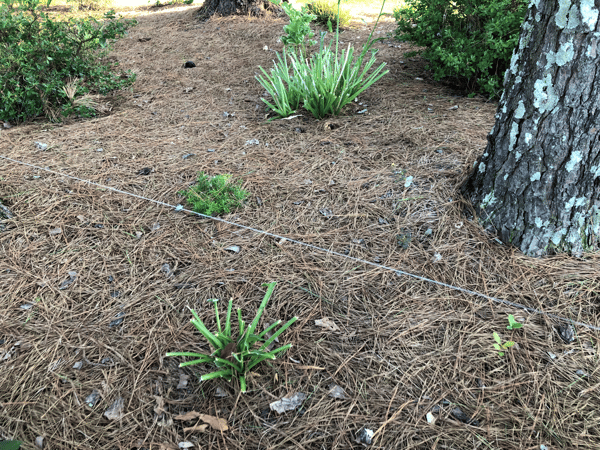 Fishing line to block deer is ineffective and more likely to be a trip-line for unsuspecting humans.
Fishing line to block deer is ineffective and more likely to be a trip-line for unsuspecting humans. - Don't put fine black mesh over plants, especially close to the ground. More often than not, a curious snake will make its way into that netting. If you have never had to cut a snake from mesh, consider yourself fortunate. It is stressful for both parties and if you do not aid in the rescue the snake will die. Most snakes play vital roles in managing the mammal population that we are at odds with, so this is counterproductive.
Know What You are Dealing With
I’d like to share some advice on practical, cost-effective strategies that I have employed with success to manage a wide variety of hungry visitors over the years. One of the key components is to first identify what animal is causing the damage.
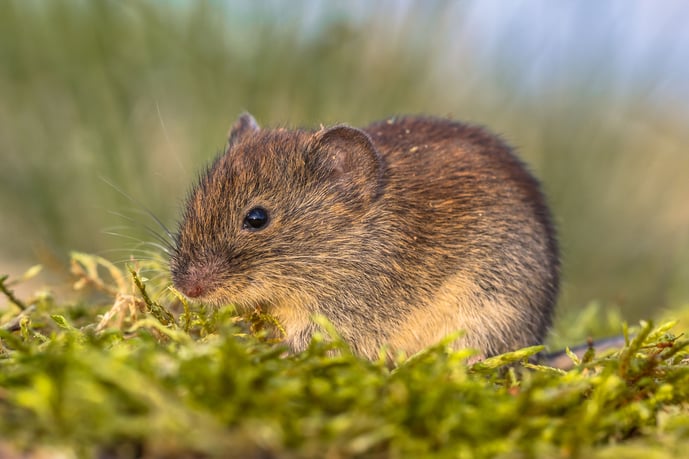 Voles are often confused with moles but they cause different kinds of damage. Voles gnaw at the roots of your plants, eat your grass and spring bulbs, and chew on the bark of trees and shrubs.
Voles are often confused with moles but they cause different kinds of damage. Voles gnaw at the roots of your plants, eat your grass and spring bulbs, and chew on the bark of trees and shrubs.
Most gardeners deal with a variety of visitors at different times of the year. For instance, deer tend to be most problematic in fall during rut, when males are rubbing the velvet from their antlers. This is when you see major damage to small-caliper trees and shrubs. Spring and summer tend to be when heaviest deer browse occurs, as mothers teach their fawns to navigate through your neighborhood. The rabbits and groundhogs also seem to be big spring and summer eaters, whereas the squirrels are busy digging through autumn and winter.
My Favorite Critter Strategies
Repellents
To successfully use repellent, you need to apply a formulation that is specific for the animal you are trying to deter. You see “deer spray” doesn’t necessarily work for deterring rabbits, squirrels, or that neighborhood dog that uses your mailbox planting as a toilet every day.
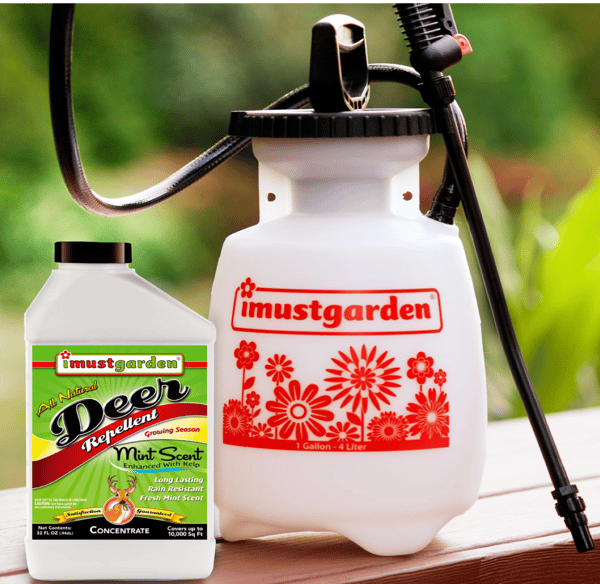
That is why I love the I Must Garden line of animal repellents. Not only do these animal-specific concoctions work, they smell good so none of your neighbors will be offended.
Water Surprise
Motion-activated irrigation is another great way to deter browsers in your garden, especially at night. You don’t need an irrigation system, as you can buy the sprinkler and attach it to a hose that can be moved daily to add an additional element of surprise. I like the Orbit Yard Enforcer™ pictured below.

The idea is simple: Just like a motion light, the irrigation sensor is triggered by movement and a sudden burst of water will shoot out, spooking the intruder – both animal and human. One key thing to note: be sure to turn it off if you are throwing an evening dinner party!
Vole King Bags
Earlier this year I was introduced to Vole King at a Super-Sod event. This ingenious product literally gives you an insurance policy from in-ground mammals like voles, which cause so much damage in the southeast. They range in sizes from half gallon all the way up to 15 gallon, so there is a vole king bag for every plant that you purchase.
The idea is simple, just remove your new plant from its pot and place the root ball in a Vole King bag. Then plant and fold the stainless steel mesh over the top to ensure that voles can’t get inside. Of course, the roots will eventually grow out of the bag, but the voles won’t be able to get to the critical root mass - the tap root.

This is an inexpensive effective strategy for planting, especially things like tulip bulbs which are a voles' #1 choice. I use the Vole King bags for every new plant that I put into my landscape now. I just wish I had known about this product earlier!
Plants that Repel
Certain plants can also offer a practical solution. Consider specimens with large thorns and a low, branching habit, such as the hardy citrus Poncirus trifoliata ‘Flying Dragon’ (Zones 5-9) to help block deer runs and direct other animals around your property. For those of us in warm climates, agave can add an extra layer of protection, but be careful because those spikes hurt.
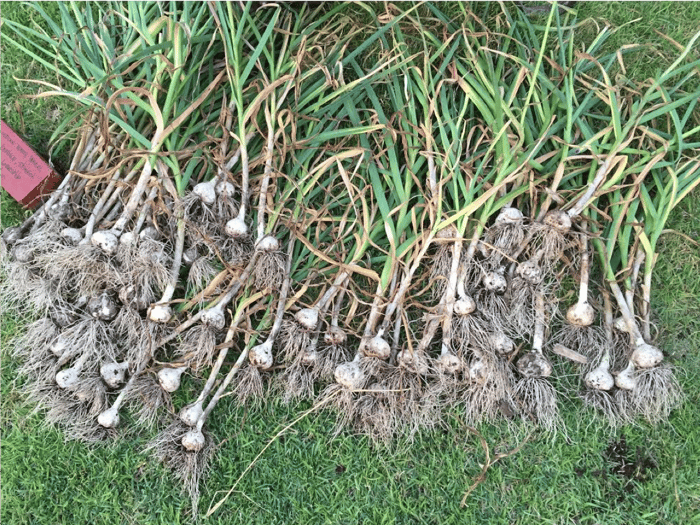
Garlic deters underground pests like voles and moles. It is easy to grow and provides a tasty addition to your meals.
Flowering annuals with a strong scent, like lantana, in both the bush and groundcover form, will drive a nibbling rabbit to the next county. And traditional herbs are also great deterrents. It seems people are the only ones who enjoy the flavor of rosemary, thyme, sage, and oregano. Many seasonal edibles are also effective at discouraging grazing mammals. Did you know that garlic bulbs will help ward off moles and voles? And small leaf varieties of basil will put off rabbits due to the bitter flavor of the leaves.
I never say any plant is “deer-proof,” because as soon as I make that declaration a herd will prove me wrong. However, I will say there are several plants that can help reduce browsing damage from all the common culprits.
The Old Bed-Edge Trick
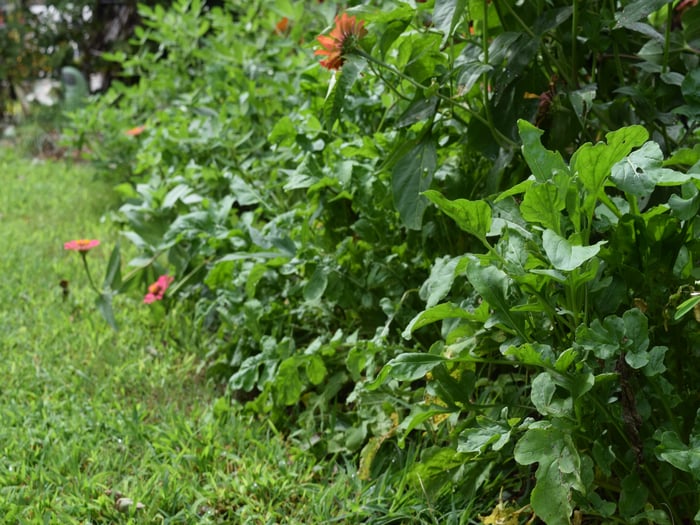 Fill your bed edges with plants that deter grazing mammals like: spicy greens, basil, garlic, onions, peppers, and potatoes.
Fill your bed edges with plants that deter grazing mammals like: spicy greens, basil, garlic, onions, peppers, and potatoes.
Bed edges offer the ideal location to deter animals, because it is the first area they come to. If they sniff or taste something that isn’t appealing, they tend to run off, hopefully to someone else’s yard! It is also convenient for watering and harvesting. I have found that many of the most practical food crops I grow for daily eating are the best for warding off the troublemakers.
Plant a Cool Season Edge
Let’s talk about which cool season veggies you can plant now along your bed-edges to repel browsing mammals. These are best planted between September and March and harvested from November to May.

Topdressing a bed with Soil³ compost before planting.
Of course, I must mention the importance of soil. All the plants I recommend below prefer to grow in full sun with enriched soil, specifically Soil3 Humus Compost. Each season before I plant, I top dress my beds with 1-2” of Soil3 and then plant directly in it. This ensures that they won’t dry out or get too wet and will have access to organic nutrients. I never plant anything without Soil3 compost!
Arugula (Eruca versicaria)
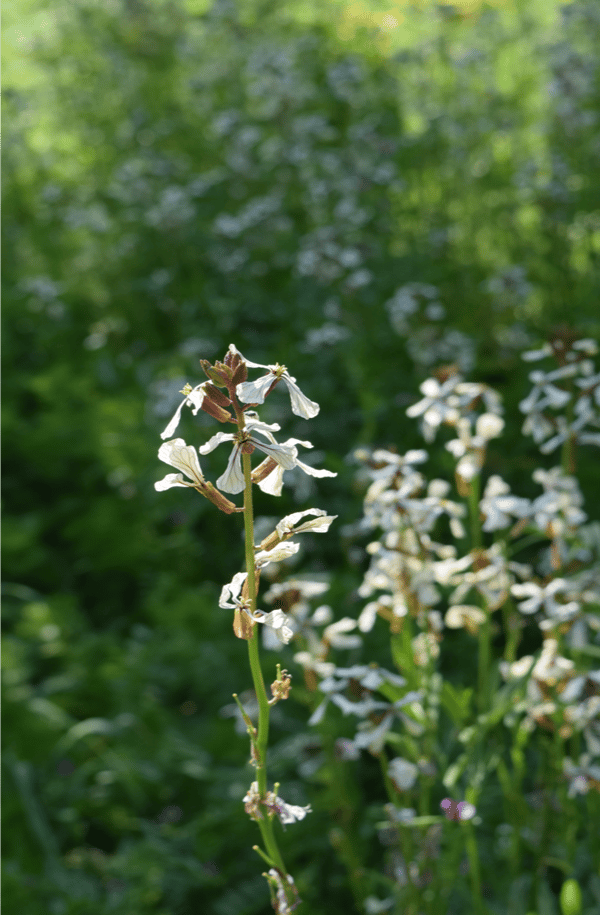
Arugula is an excellent source of vitamins and anti-oxidants. While rabbits don't like the peppery flavor, the leaves and even the flowers are a zesty treat for us.
This cool season green will add spice and flavor to your salad and can be served “wilted” to complement hearty dishes. Grown easily from seed, arugula looks great planted in mass along a border edge, making harvest easy and convenient. Though people covet the flavor, rabbits and groundhogs are extremely offended by it, making this a top candidate for growing.
I recommend directly sowing the seed along a sunny border in a light layer of compost. It will germinate quickly, and the leaves can be harvested at every stage of development - even when it flowers! As the summer heat kicks in, allow the seeds to ripen, ensuring you will have another crop when temperatures moderate.
Garlic (Allium sativum)
As one of my all-time favorite edibles to grow, garlic belongs along the edge of every sunny landscape because it is a great plant to help deter in-ground pests such as voles and moles, while creating an effective barrier through its foliage for deer, rabbits and groundhogs.
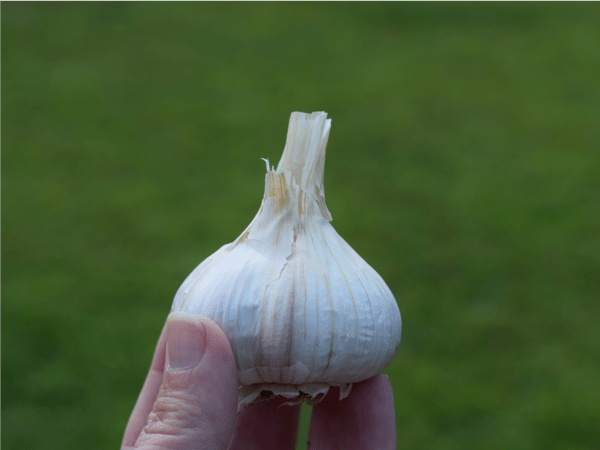
Garlic is fun to grow and can provide abundant harvests with little maintenance. My favorite variety is Music - it is cold hardy, rich flavored, and stores well.
Considering 90% of the garlic sold in American grocery stores is imported from China, this favorite culinary bulb has some serious food miles attached to it. It is easy to grow with very little maintenance and can be contained to the edge along any sunny border.
Garlic grows from a vegetative division that is best planted in fall through-out North America. I usually give a broad window for planting - Labor Day till Christmas. This will ensure the bulbs develop for an early summer harvest.
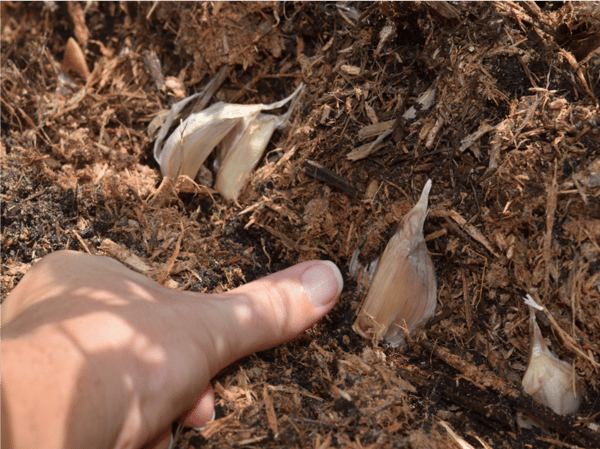
Thumb individual garlic cloves into your bed edge in fall and harvest full bulbs next summer.
Planting garlic is easy and fun! Just thumb in the raw individual cloves without removing the paper. They do not need to be planted very deep ½”-1” at most. I like to create a solid barrier, so I plant my cloves about ½” apart. One critical aspect of garlic growing is to remove the flower-scape when you see it develop in spring. This enables the plant to put all its energy into bulb production rather than flowering and setting seed.
Every clove you plant will develop into a bulb over the season, providing ample access to homegrown, organic garlic with zero food miles attached! With low water and fertility needs, this just may be the most practical food crop to grow at home.
Potatoes (Solanum tuberosum)
 Every kid loves French fries, so why not teach them where their favorite food starts?
Every kid loves French fries, so why not teach them where their favorite food starts?
Potatoes are a very low-maintenance crop that can produce an abundance of edible tubers through the cool season. Since it is in the Solanaceae family, the foliage is poisonous and browsing mammals steer clear.
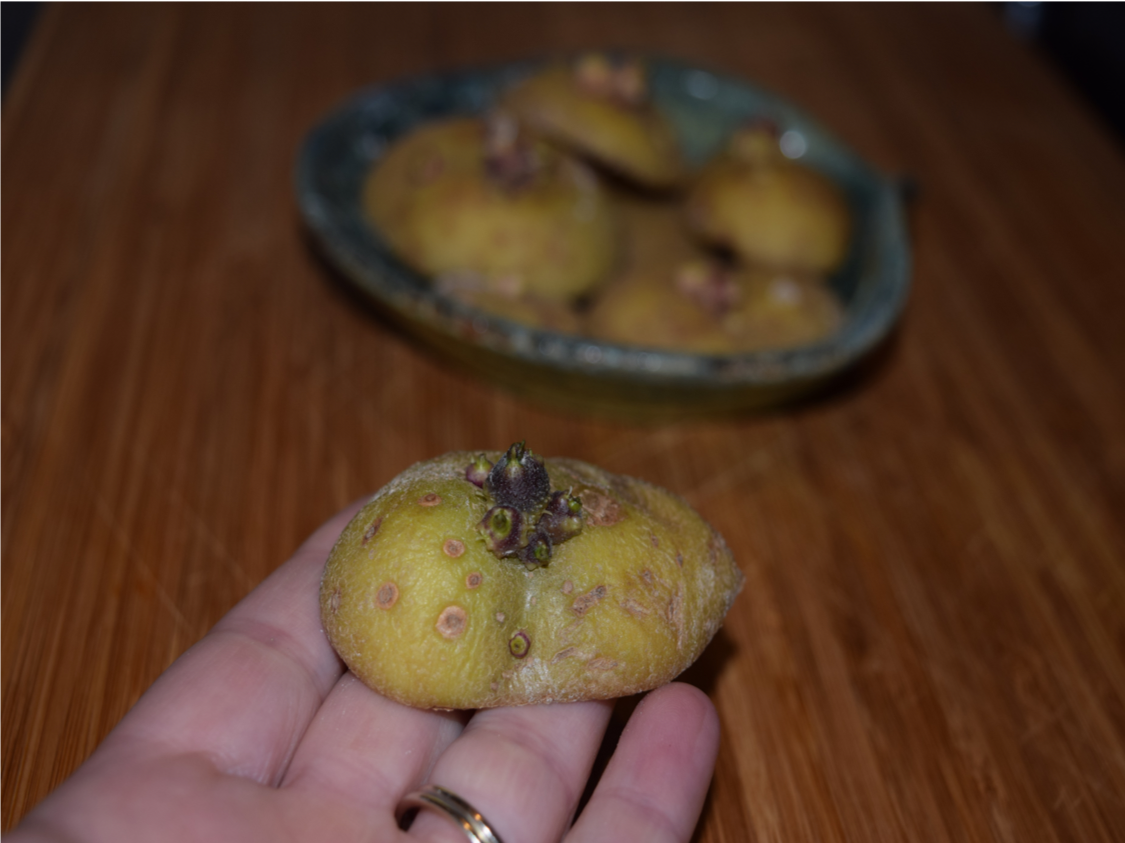 I grow my ‘taters the old-fashioned way, in the ground. But I start in my pantry: As my potatoes begin to sprout inside, I cut the growing eyes off in chunks and allow the pieces to dry for several days before planting. Dig a trench 18-24” deep around your landscape borders and toss in those vegetative "cuttings,” dropping a piece every 8". Cover the trench, walk away and 3-4 months later it will be time to harvest. The foliage will turn yellow, signaling that it is time to dig. You can easily grow large quantities of potatoes along a landscape edge. I leave the smallest tubers in the ground, ensuring the next season’s harvest and am never without homegrown, organically raised potatoes.
I grow my ‘taters the old-fashioned way, in the ground. But I start in my pantry: As my potatoes begin to sprout inside, I cut the growing eyes off in chunks and allow the pieces to dry for several days before planting. Dig a trench 18-24” deep around your landscape borders and toss in those vegetative "cuttings,” dropping a piece every 8". Cover the trench, walk away and 3-4 months later it will be time to harvest. The foliage will turn yellow, signaling that it is time to dig. You can easily grow large quantities of potatoes along a landscape edge. I leave the smallest tubers in the ground, ensuring the next season’s harvest and am never without homegrown, organically raised potatoes.
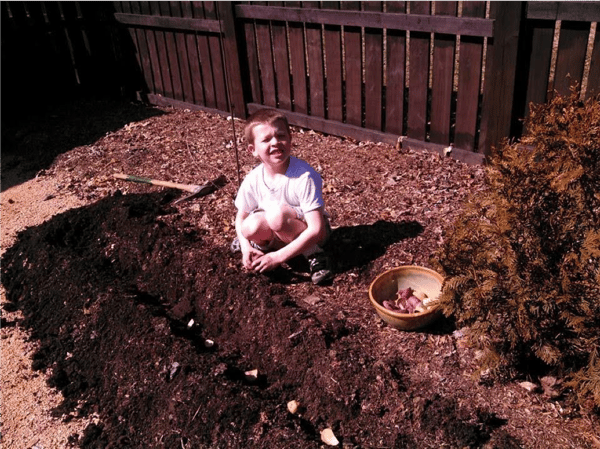
Three months later we harvested 80 lbs of potatoes from the garden!
Always use a wide-tined fork to harvest potatoes. This will reduce the number of tubers that get stabbed, which causes rapid decay. Post-harvest, I store the unwashed potatoes in brown bags inside my pantry for several weeks before starting to cook them. This allows the sugars to settle into starch.
Plant Extra!
I remember a former boss saying that the best way to deal with deer is to get your neighbor to garden. After all, most of the strategies I have just explained aren’t going to eliminate the creatures… you are just encouraging them to go to someone else’s yard!
The idea behind that isn’t entirely selfish. The more delicious plants that are spread through-out your neighborhood, the less likely you will be to find your garden totally ravaged. So, consider planting some extra “deer food” and encourage the beasts to follow your property perimeter, thus leading to some other landscape.
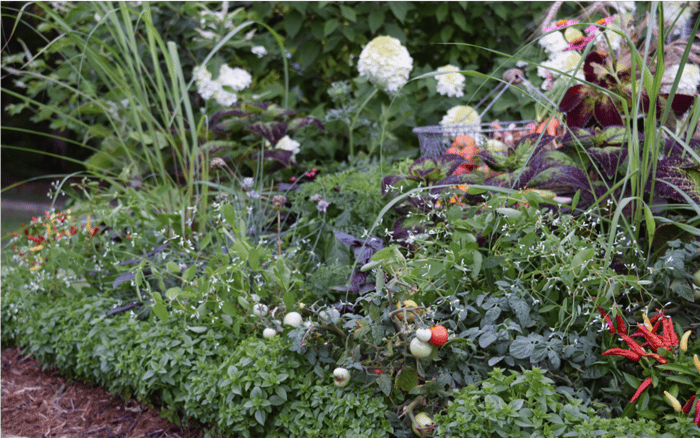
Bed edge filled with ‘Micrette’ Dwarf Basil and other plants to deter hungry mammals from browsing my garden.
As always, I wish you the best in your growing adventure and welcome your insights on managing browsing mammals. Drop me a note below if you have discovered a strategy that works, or doesn’t, so we can all learn together!
Happy planting, Brie
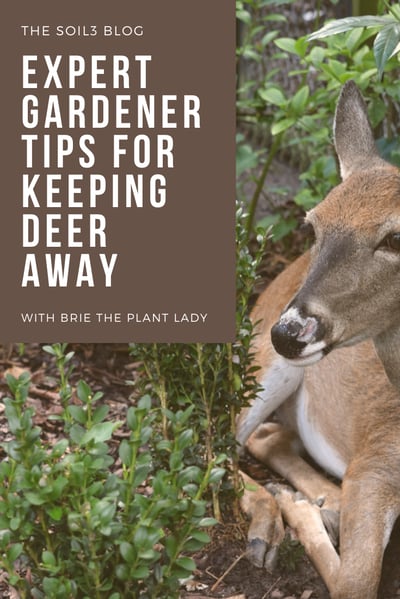
Related Posts


Summer Evaluations: 3 Success Stories with Soil3
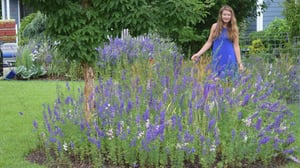
It's Fall! Here's What Brie is Planting to Keep Things Flourishing - Both Now and For the Spring
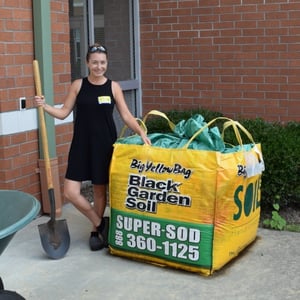
Introducing Brie the Plant Lady
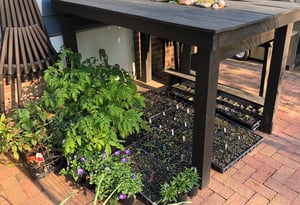
It's Spring - Time to make a realistic landscape plan
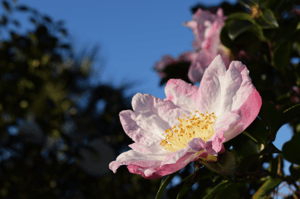

Did this help you out? Have any questions for clarity? Leave a comment below!